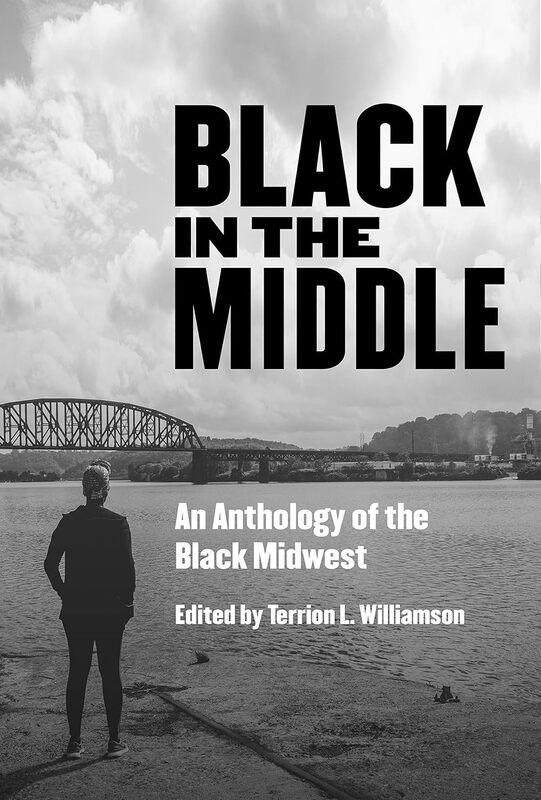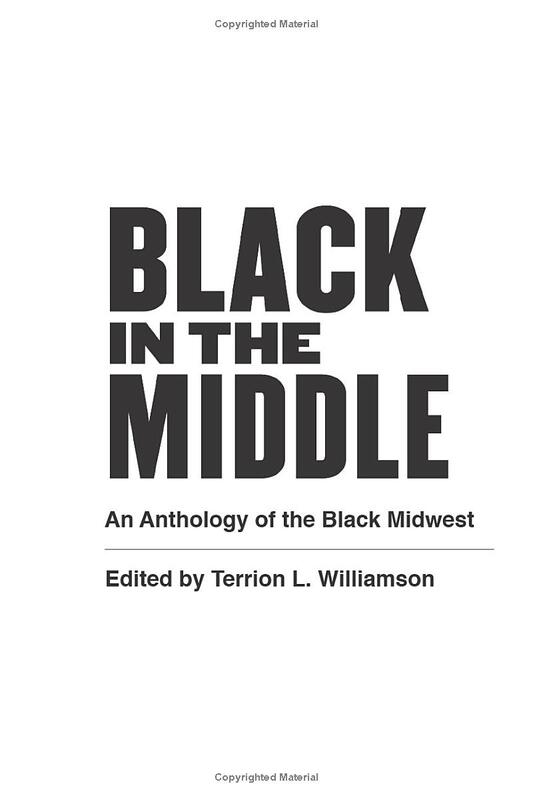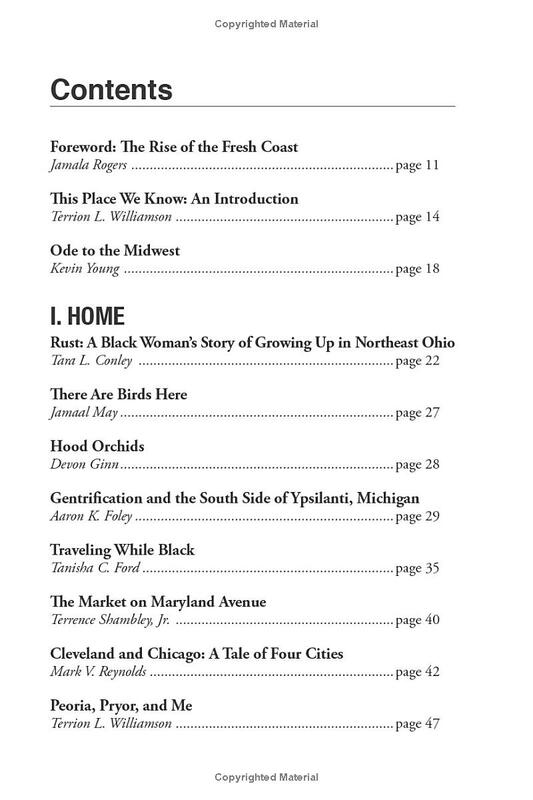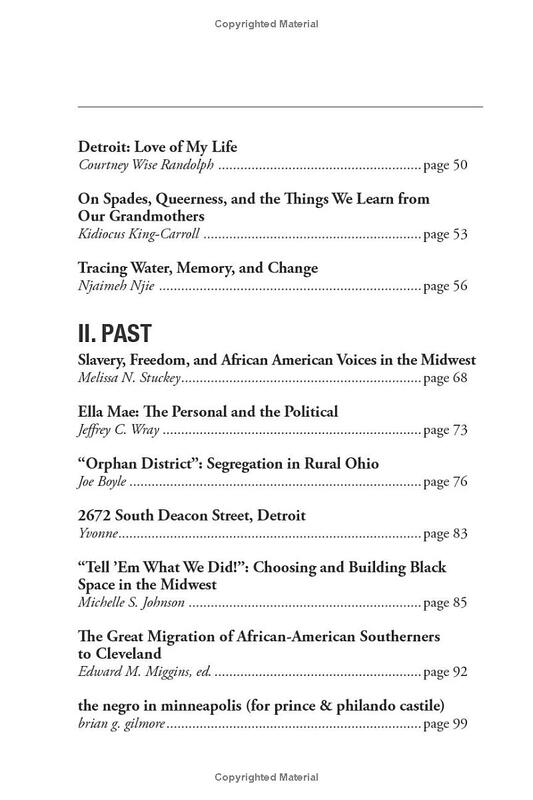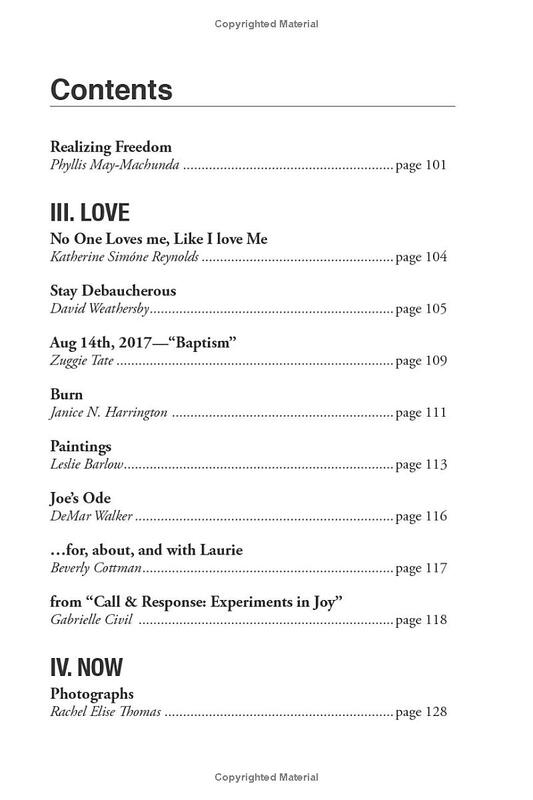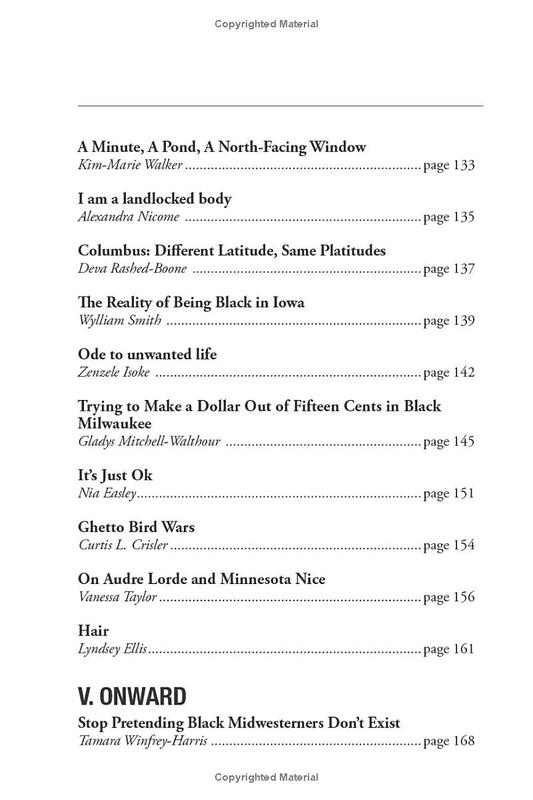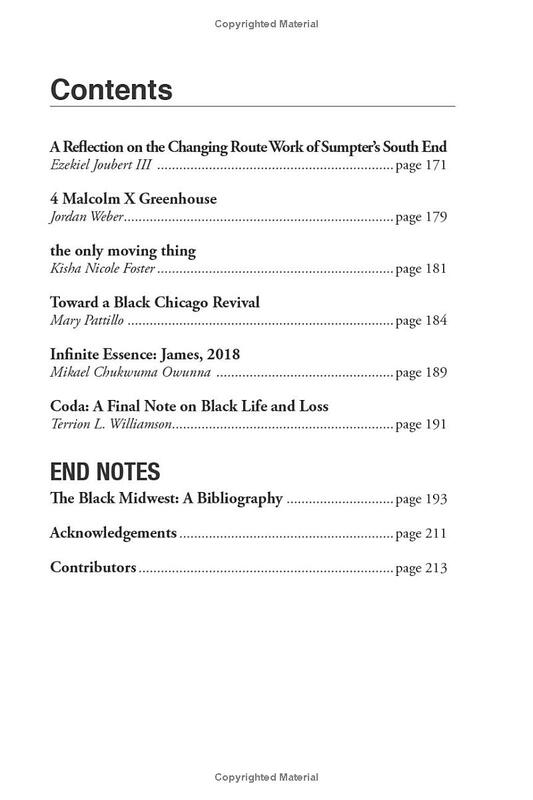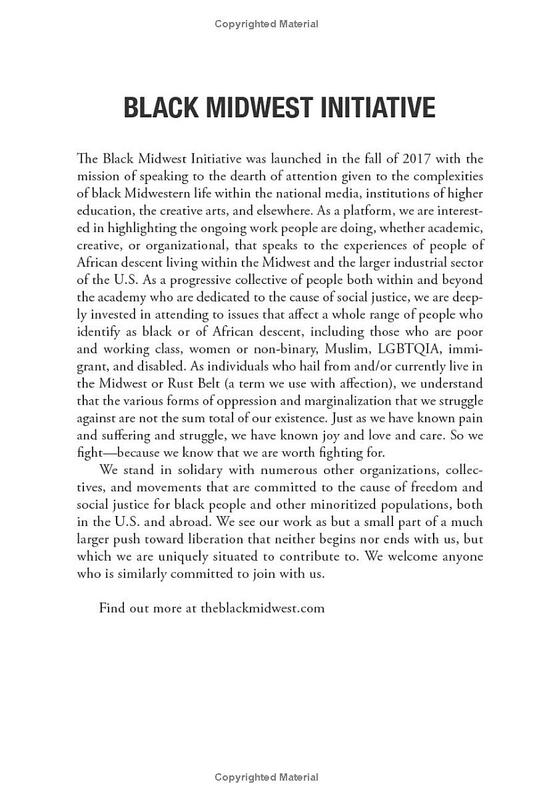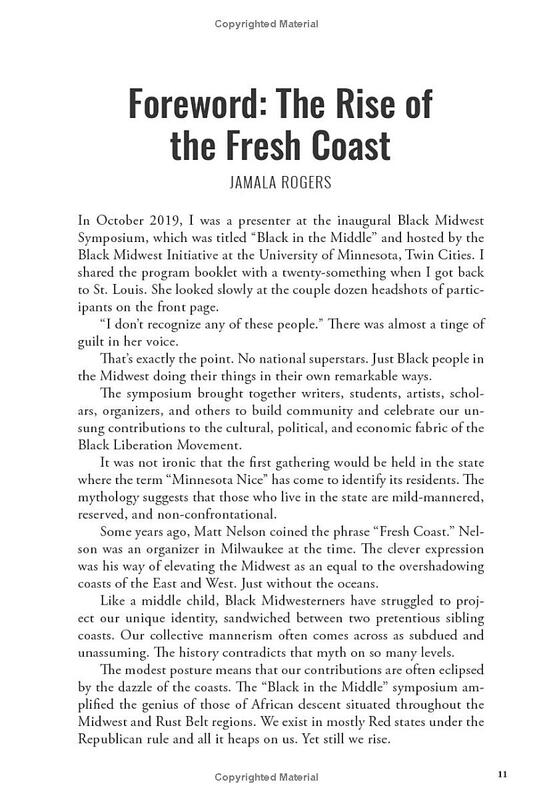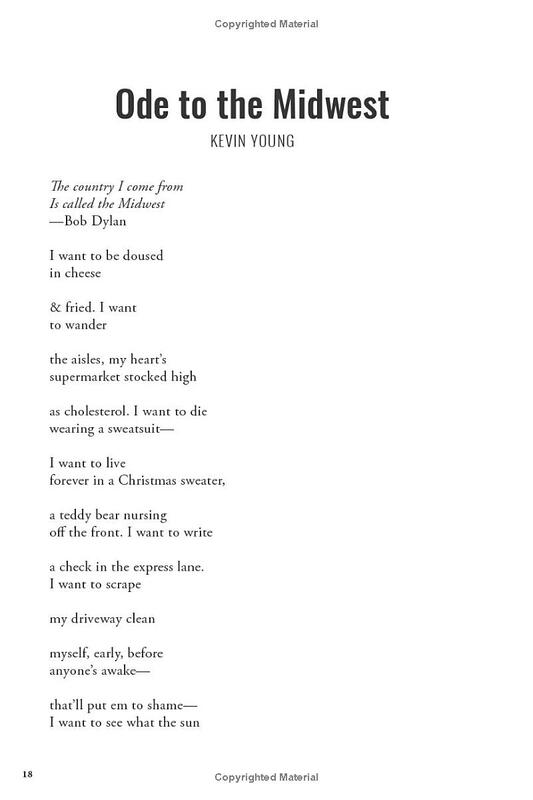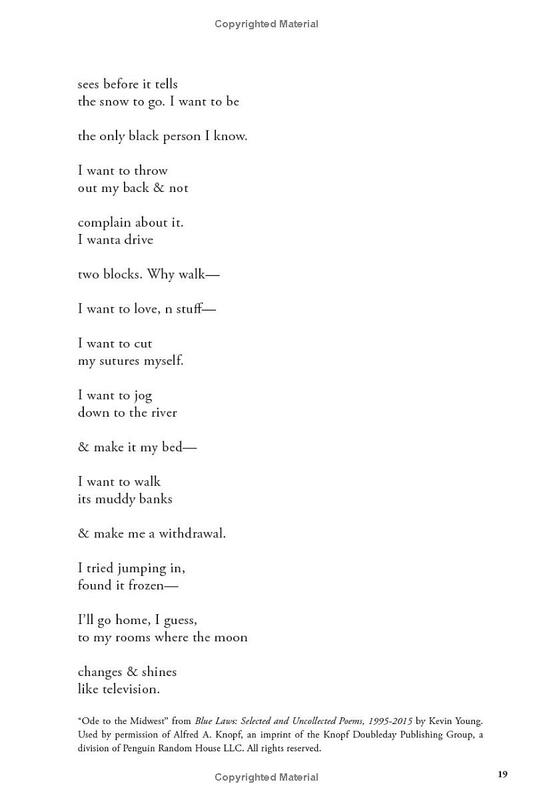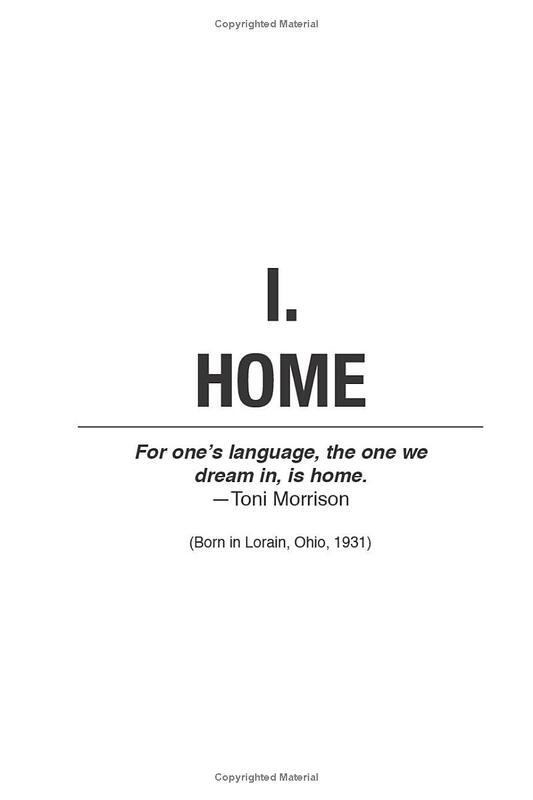Black in the Middle: An Anthology of the Black Midwest
Item
-
Title
-
Black in the Middle: An Anthology of the Black Midwest
-
This edition
-
"Black in the Middle: An Anthology of the Black Midwest". Ed. Terrion L. Williamson. Cleveland, OH: Belt Publishing, 2020. 224 pp.
-
Table of contents
-
[* indicates that a contributor is not African American]
● Jamala Rogers / Foreword : The Rise of the Fresh Coast
● Terrion L. Williamson / This Place We Know: An Introduction
● Kevin Young / Ode to the Midwest
I. Home
● Tara L. Conley / Rust: A Black Woman's Story of Growing Up in Northeast Ohio
● Jamaal May / There Are Birds Here
● Devon Ginn / Hood Orchids
● Aaron K. Foley / Gentrification and the South Side of Ypsilanti, Michigan
● Tanisha C. Ford / Traveling While Black
● Terrence Shambley, Jr. / The Market on Maryland Avenue
● Mark V. Reynolds / Cleveland and Chicago: A Tale of Four Cities
● Terrion L. Williamson / Peoria, Pryor, and Me
● Courntey Wise Randolph / Detroit: Love of My Life
● Kidiocus King-Carroll / On Spades, Queerness, and the Things We Learn from Our Grandmothers
● Njaimeh Njie / Tracing Water, Memory, and Change
II. Past
● Melissa N. Stuckey / Slavery, Freedom, and African American Voices in the Midwest
● Jeffrey C. Wray / Ella Mae: The Personal and the Political
● Joe Boyle* / "Orphan District": Segregation in Rural Ohio
● Yvonne / 2672 South Deacon Street, Detroit
● Michelle S. Johnson / "Tell 'em what we did!": Choosing and Building Black Space in the Midwest
● Edward M. Miggins, ed. / The Great Migration of African-American Southerners to Cleveland
● brian g. gilmore / the negro in minneapolies (for prince & philando castile)
● Phyllis May-Machunda / Realizing Freedom
III. Love
● Katherine Simóne Reynolds / No One Loves Me, Like I Love Me
● David Weathersby / Stay Debaucherous
● Zuggie Tate / Aug 14th, 2017--"Baptism"
● Janice N. Harrington / Burn
● Leslie Barlow / Paintings
● DeMar Walker / Joe's Ode
● Beverly Cottman / . . . for, about, and with Laurie
● Gabrielle Civil / from "Call & Response: Experiments in Joy"
IV. Now
● Rachel Elise Thomas / Photographs
● Kim-Marie Walker / A Minute, A Pond, A North-Facing Window
● Alexandra Nicome / I am a landlocked body
● Deva Rashed-Boone / Columbus: Different Latitude, Same Platitudes
● Wylliam Smith / The Reality of Being Black in Iowa
● Zenzele Isoke / Ode to unwanted life
● Gladys Mitchell-Walthour / Trying to Make a Dollar Out of Fifteen Cents in Black Milwaukee
● Nia Easley / It's Just Ok
● Curtis L. Crisler / Ghetto Bird Wars
● Vanessa Taylor / On Audre Lorde and Minnesota Nice
● Lyndsey Ellis / Hair
V. Onward
● Tamara Winfrey-Harris / Stop Pretending Black Midwesterners Don't Exist
● Ezekiel Joubert III / A Reflection on the Changing Route Work of Sumpter's South End
● Jordan Weber / 4 Malcolm X Greenhouse
● Kisha Nicole Foster / the only moving thing
● Mary Pattillo / Toward a Black Chicago Revival
● Mikael Chukwuma Owunna / Infinite Essence: James, 2018
● Terrion L. Williamson / Coda: A Final Note on Black Life and Loss
End Notes
● The Black Midwest: A Bibliography
● Acknowledgements
● Contributors
-
Publisher's description
-
"Black in the Middle brings the voices of Black Midwesterners front and center. Filled with compelling personal narratives, thought-provoking art, and searing commentaries, this anthology explores the various meanings and experiences of blackness throughout the Rust Belt, the Midwest, and the Great Plains. Bringing together people from major metropolitan centers like Detroit and Chicago as well as smaller cities and rural areas where the lives of Black residents have too often gone unacknowledged."
-
Reviews and notices of anthology
-
Review of "Black in the Middle," edited by Terrion Williamson. "Publishers Weekly" 13 July 2020.
"Williamson (Scandalized My Name), director of the Black Midwest Initiative, presents a timely and evocative anthology of essays, poetry, photographs, and interviews in order “to make visible the struggle and the agony, yes, but also the diversity and richness of black Midwestern life.” Common themes include the impact of the Great Migration on the Midwest, and the burdens and achievements of Black women. Jeffrey Wray, a film studies professor at Michigan State, writes movingly of his mother’s pursuit of higher education after her husband’s murder in 1968. Vanessa Taylor, editor-in-chief of The Drinking Gourd, describes how she embraced the power of “Black women’s rage” during protests against the 2015 killing of Jamal Clark by Minneapolis police. Essayist Lyndsey Ellis offers an intensely personal account of embracing natural hair in college; filmmaker David Weathersby details the “mass of Afro-eroticism and liberation” he saw at a clandestine house music party in Chicago; and law professor Brian G. Gilmore links Philando Castile, F. Scott Fitzgerald, Dred Scott, and Lester Young in his poem “the negro in minneapolis (for prince & philando castile).” By calling forth the full range of the Black Midwestern experience, this bracing anthology offers crucial insights into why the region is the epicenter of current protests against police brutality and racial injustice." [full-text]
-
Publishers Weekly
-
Thompson, Erica. "New Anthology Explores Black Life in the Midwest." "The Columbus Dispatch" 30 Aug. 2020.
"[T]he collection explores the experiences of Black Midwesterners through personal narratives, commentaries, poetry, photography and more."
"In “Black in the Middle,” Williamson asserts that Black life everywhere is “conditioned by precarity.” However, she argues that Black Midwesterners’ stories have been overlooked in the national narrative. “Even as electoral campaign cycles mobilize ... around the plight of heartland laborers, the disproportionate and specific consequences of deindustrialization, population loss, and economic decline on Black Midwestern communities remains conspicuously unaddressed,” she writes."
"Chicago native Mark V. Reynolds wrote about the persistence of segregated neighborhoods in his essay, “Cleveland and Chicago: A Tale of Four Cities.” “I think Black people obviously are aware of (the current segregation),” said Reynolds, 61, who lived in Cleveland for years before returning to the Windy City. “I’m not sure that everyone else is — or maybe they just take it for granted as the way things are. And that’s one of the pernicious things about segregation and racism is that it’s become so ingrained that people don’t question it.”"
"Joe Boyle, a 45-year-old history teacher at a Toledo high school, is not Black, but he said he wanted to contribute research from his master’s project to help illustrate “the diversity of experience for African Americans in the Midwest.” Boyle’s piece, “‘Orphan District:’ Segregation in Rural Ohio,” examines the Spencer-Sharples Local School District in Toledo. The predominantly Black area suffered neglect due to unjust policies in the 1950s and ‘60s. “(It’s) a cautionary tale about Ohio’s education policy and about the inherent unfairness in an over-reliance on property tax,” Boyle said. “And while that is improved today, it’s still something that just exacerbates every inequality in our society and the state.” He said he plans to use other contributions in the book in his history class. “For anybody in the Midwest, this is an important read if we’re truly trying to make the kind of progress that we say we’re trying to make right now in light of Black Lives Matter and in light of his cultural re-examining of race in America,” Boyle said.""
-
The Columbus Dispatch
-
Zelman, Brett. "Ohio's Belt Publishing Releases 'Black in the Midwest' [sic!], a New Book of Essays about the Black Experience and Racial Identity." "CityBeat" [Cincinnati] 9 Sept. 2020.
"The anthology is a mixture of essays, poems and personal narratives that touch on all aspects of the Black experience in the midwest. . . . "Bringing together people from major metropolitan centers like Detroit and Chicago as well as smaller cities and rural areas where the lives of Black residents have too often gone unacknowledged, this collection is a much-needed corrective to the narrative of the region,” according to a press release from Belt."
-
CityBeat [Cincinnati]
-
Danielsen, Aarik. "Bearing Witness." Review of "Black in the Middle." "Columbia Daily Tribune" 11 Sept. 2020.
"Recycled stories will never reshape greater cultural narratives. They simply encourage history to loop back over itself; they separate people living within a moment from the joy of growing to fit an expanded vision of their time and place.
Those with the ears to hear seek out fresh testimonies, a kind of truth-telling beyond their own experience. More often than not, they discover that these new-to-them voices have been sounding all along.
“Black in the Middle: An Anthology of the Black Midwest,” from Cleveland-based Belt Publishing, contributes to the flourishing of two audiences. For Black readers, the book will serve as affirmation of their lived realities, an anthem spurring them to keep placing one foot in front of the other on the path to progress.
Receptive readers outside the Black community — especially white Midwesterners — will deepen and widen their understanding of their neighbors. And, if they embrace the book’s plainspoken revelations, these stories will reframe the region as more beautiful, full and burdened than they ever realized."
-
Columbia Daily Tribune
-
St. Jude, Jen. "Recovering Narratives in 'Black in the Middle.'" "Chicago Review of Books" 11 Sept. 2020: [includes an interview with the editor of the anthology, Terrion L. Williamson]
This anthology grows out of the work of the Black Midwest Initiative [see below]: "Politicians and the media had long erased Black Midwesterners from the national conversation, spurring Terrion Williamson, the current Director of Black Midwest Initiative, to begin plans for the Initiative well before the 2016 presidential election. In the wake of the election, the Black Midwest Initiative took form and in October of 2019 they hosted a symposium and organized the publication of 'Black in the Middle: An Anthology of the Black Midwest' to continue the conversations that sparked there. Williamson, who is also the editor of the anthology, committed to including artists across different landscapes. Poets, visual artists, sound artists, and filmmakers all contributed their words, art, and photography to the project. Williamson also purposely chose Belt Publishing, an independent press outside of the academic space, to elevate a range of voices."
Terrion Williamson: "There is a dearth of attention to the rich Black cultural production that emerges out of the Midwest. It’s really obvious when you start naming people who are well-known or culturally influential, there’s a whole host of folks, but there’s a way in which people have been displaced from their Midwestern roots. For instance, few people would deny how important Toni Morrison is to American letters and American literature, but she’s sometimes been displaced as a Midwestern writer. Or the way that somebody like Richard Prior gets so much of his material from his childhood years growing up in Peoria, Illinois, and yet that’s often left out of his story. Biographers never forget to mention that Pryor was raised in brothels in Peoria, certainly, but so much of what made his material culturally viable was shaped by his experiences in his hometown — and his hometown, 'our' hometown, has also worked to displace him in some ways. The Initiative and the book project are recovering those narratives as well. We’re making visible the struggles we’ve had, but also the successes and impact that Black Midwesterners have had across the American landscape and cultural productions."
Terrion Williamson: "To talk about the Midwest is to talk about class in a really deep way, at least to me, because I can’t have a conversation about Black folks in the Midwest and not have a conversation that’s deeply implicated by class struggle. Class struggle is central to the concept of Black community formations. Part of the narrative that seems to be missing from or that gets distorted in the national narrative is the connection that so many Black Midwesterners have to working-class, under-resourced, inner-city life in ways that are structurally produced. This is what Jason Hackworth discusses in Manufacturing Decline, for instance, the specificity of urban decline, which is always read as Black, in northern industrial cities. So many of us are coming from places like the South Side of Chicago, Detroit proper (not metro Detroit, Detroit Detroit), North Minneapolis — all these communities that get talked about as failing or declining. And even if we are not ourselves working-class people any longer, many of us came from working-class families and communities. So, for me, to be a Black Midwesterner is to be constantly thinking about how I am situated across a range of economic and cultural modalities."
Terrion Williamson: "There’s also all this Southernness. My best friend and I grew up on the same street in Peoria and became best friends in fifth grade. We eventually found out my father and his family and her mother and her family all grew up in the same community in West Memphis, Arkansas and even went to the same high school. There are so many stories like that, where there are family roots that go back to the South, but people end up in these Black enclaves in the Midwest. There’s all this connection to southern culture but that functions differently in the cities of the Midwest. It’s about being grounded in an everyday Black sociality that is tied to the land, to particular kinds of familial and communal formations that feel familiar wherever I go."
Terrion Williamson: "I do hope that it has mass appeal and I can think of all different types of audiences. There’s not just one person but, if I have to pick just one, I want to speak to the young Black person growing up in Gary, Indiana who doesn’t see themselves in any kind of meaningful national narrative. I want us to be speaking to other Black folks in this region, particularly those in places that never get talked about as part of the national conversation, except to be viewed as a narrative of decline, decay, pathology. People need to see there are others of us who come from communities who are doing meaningful work in our lives and we’re not all talking about getting out. There are some who leave, and that’s okay, but there are many of us who stay. I don’t live in Peoria anymore, but it’s home and it shows up in my work all of the time. It’s a beloved place for me. That’s my homeplace and I might criticize it, but that critique comes out of a deep desire to make it better, a deep commitment to making it better for the people who are there."
Terrion Williamson: "I do hope that it has mass appeal and I can think of all different types of audiences. There’s not just one person but, if I have to pick just one, I want to speak to the young Black person growing up in Gary, Indiana who doesn’t see themselves in any kind of meaningful national narrative. I want us to be speaking to other Black folks in this region, particularly those in places that never get talked about as part of the national conversation, except to be viewed as a narrative of decline, decay, pathology. People need to see there are others of us who come from communities who are doing meaningful work in our lives and we’re not all talking about getting out. There are some who leave, and that’s okay, but there are many of us who stay. I don’t live in Peoria anymore, but it’s home and it shows up in my work all of the time. It’s a beloved place for me. That’s my homeplace and I might criticize it, but that critique comes out of a deep desire to make it better, a deep commitment to making it better for the people who are there."
Jen St. Jude: "The book’s publishing date was September 1st. We are in this current moment reckoning with the police violence that killed George Floyd and hurt so many others. We’re seeing uprisings across the country. Not that any of this is new in terms of racial injustice or violence against Black people — this is not a new moment — but it does feel different to me this time in part because we’re quarantined and don’t have the excuse of being distracted by other things in life. I don’t think you could have imagined that the publishing date would feel the way that it does right now. What does that experience feel like?"
Terrion Williamson: "It’s all been just so surreal, so unexpected. This book has been in the works since last October. I sent it off and wrote the introduction in February. It does feel different and I’m concerned about something we’re losing a bit: I think it’s important where it all originated. This particular moment started in Minneapolis. The Black Midwest Initiative put out a statement and what we wanted to be clear on was that it matters that it happened in Minneapolis. If you think about some of the most recent high-profile uprisings or police-involved cases, they’ve occurred in the Midwest. Think about Ferguson and the killing of Michael Brown and the murders of Jamar Clark and Philando Castile here in the Twin Cities in just the past five years. Think about Tamir Rice and Laquan McDonald in 2014 and Rekia Boyd two years before that and Aiyana Jones two years before that. There’s a correlation between the violence Black people are experiencing and these indexes that are naming the “worst places to be Black.” Most of those so-called “worst places” are in the Midwest. And a city like Minneapolis shows up on the “worst of” lists for Black people at the same time that it is named one of the most livable cities in the country. Livable for who? It’s really important to not lose sight of this as attention shifts. These recent rebellions have necessarily moved outward and became more national, and while of course police brutality and the injustices people are protesting are a nationwide crisis, there is also something specific about what’s happening here in the Midwest. It matters that some of the places seeing the highest rates of poverty, segregation, and incarceration are in the Midwest."
-
Chicago Review of Books
-
Williams, Joseph P., Jr. Review of "Black in the Middle," edited by Terrion L. Williamson. "Minnesota Star Tribune" 18 Sept. 2020:
"“Black in the Middle” [is] a collection of poetry, prose and photography that Williamson has curated and crafted into a manifesto of sorts, staking claim to America’s Heartland. The artists and authors define what it means to be among the 7 million Black people who call the region home; they declare the diaspora is thriving in a land where the value set — hard work, integrity, modesty and fair play — isn’t associated with people who look like them. “Black in the Middle” upends the Midwest’s whites-only stereotype, reminding readers that the land of cornfields, steel mills, Garrison Keillor and State Fair dairy queens is the same place that Prince, LeBron James, Gwendolyn Brooks, Malcolm X and Toni Morrison came from."
"Williamson’s affectionate tour of Flyover Country is ambitious and eclectic, with African American humanity on display. Stops include a lecherous underground ball in Chicago, a gentrifying ’hood in Ypsilanti, Mich., a spades game in Milwaukee’s North Side, and the University of Iowa, a vast 33,000-student school with fewer than 1,000 Black students. There is an homage to Peoria, Ill. (Richard Pryor’s hometown), a shout-out to St. Louis (Miles Davis and Maya Angelou) and a conflicted love letter to Detroit, a city one writer can’t seem to quit."
"But because Middle America is still America, Jim Crow lurks like a shadow, menacing. “Black in the Middle” reminds us that ol’ Jim maintained separate-but-equal schools in Ohio (Brown v. Board of Education originated in Topeka, Kan.). He abused Black diners in Cleveland who dared to eat at a de facto segregated lunch counter. He cheated African American home buyers in Chicago and killed Philando Castile in Minnesota, a place I once tried to embrace."
-
Minnesota Star Tribune
-
Fenske, Sarah. "St. Louis on the Air." [brief interview with anthology editor Terrion Williamson and contributor Lyndsey Ellis]. St. Louis Public Radio 25 Sept. 2020:
Terrion Williamson launched the Black Midwest Initiative in 2017. An associate professor and director of undergraduate studies at the University of Minnesota, she saw the complexities of Black people’s lives in the Midwest given short shrift by national media outlets. It wasn’t until the death of George Floyd in Minneapolis that she found pundits and reporters from the coasts willing to listen. “Black in the Middle: An Anthology of the Black Midwest,” which Williamson edited, was underway well before Floyd’s death. She submitted a full draft to her editor in February. After Floyd was killed by Minneapolis police in May, she added a brief epilogue. But as that two-page addendum makes clear, the book is only more relevant now. 'Part of what this collection endeavors to do is reckon with the routinized brutalities and systemic inequalities that have historically structured, and continue to structure, so much of Black Midwestern life — and which far too few people recognized as the kindling for both the actual and metaphorical fires that were set in the Twin Cities in late May,' she wrote."
-
St. Louis Public Radio (STLPR)
-
Brief notice. "Indiana Magazine of History" 118.3 (2022): 239:
"Terrion L. Williamson, director of the Black Midwest Initiative, has edited a collection of forty-eight brief essays, memoirs, interviews, poems, and photographs that offers, in her words, “individual yet deeply connected experiences of this place we know” intended “to expand the discussion of the Midwest beyond narrow political talking points and misinformed media portrayals” (pp. 16–17). Five broad categories organize the book: Home, Past, Love, Onward, and Now. “Home” offers considerations of midwestern places, such as Tara L. Conley’s “‘Rust’: A Black Woman’s Story of Growing Up in Northeast Ohio”; editor Williamson’s essay on her hometown of Peoria, Illinois; and Njaimeh Njie’s “Tracing Water, Memory, and Change,” which presents interviews with and photographs of Black midwesterners living along the Ohio River. “Past” includes Joe Boyle’s “Orphan District: Segregation in Rural Ohio”; Jeffrey C. Wray’s remembrance of his mother Ella Mae; and Brian G. Gilmore’s poem “the negro in minneapolis (for prince & philando cas-tile).” The volume concludes with a bibliography on “The Black Midwest” (updates to this 2020 document are available at https://www.theblackmidwestinitiative.com/bibliography.html)."
-
Becker, Molly. "'Defiantly Ambiguous': Life in the Black Midwest." "The Cambridge Quarterly" (2021): 296-303.
The anthology argues "that in mainstream efforts to define the region, Black stories of the Midwest have been ignored or misrepresented, despite the fact that the Midwest is home to millions of Black residents who have formed robust and thriving communities. In seeking to fill in this representational void, the anthology brings together academics, activists, artists, and students to explore the question of what it means to be Black in a region itself often overlooked or misunderstood. What emerges is a collection of poems, essays, oral histories, and photographs that consider the Black Midwestern experience from many different angles to create a reading experience that is sometimes disjointed and frustratingly organised but always compelling, and that speaks both to academics engaged in Black and Midwestern studies as well as to a more general audience seeking a starting place for learning about Black lives in the United States" (296).
During the Great Migration, "approximately 8 million Black people [moved] from the South to the North, Midwest, and West between 1890 and 1980 (p. 92). As a result, the Black // population, particularly in Midwestern cities increased significantly during the twentieth century--Detroit, Michigan, for example, saw its Black population increase from under 6,000 people in 1910 to over 120,000 by 1930. This created a demographic shift that strained the social, economic, and racial fabric of the overwhelmingly white Midwest, the effects of which are still felt today. Midwestern cities overwhelmingly remain some of the most segregated in the nation, with six of the eight most segregated cities
identified in the 2010 census located in the region. . . . Yet in the common national conception of the Midwest, the Black experience is not often considered, something the anthology, through its representation of Black lives in this region, is attempting to change. . . . And when the anthology succeeds in stripping away Midwestern stereotypes to reveal the challenges and prejudices facing the region’s Black residents, it takes on a powerful resonance that demonstrates why this type of collection is both timely and necessary" (296-97).
"[T]here is a strong emphasis throughout 'Black in the Middle' on the responsibility taken on by this anthology, which allows Black Midwesterners to tell their own stories . . . the idea of voice and language . . . permeates the anthology, and there is a deep appreciation for and understanding of the power of words to both obscure and illuminate the speaker's meaning and experience" (298).
The editor has kept editorial intervention to a minimum: this respects the autonomy of the voices of the individual contributors (298); "however, the anthology’s lack of a strong central organising principle beyond the general Midwestern theme leaves readers trying to navigate an abundance of material without many internal sign- posts. The anthology is divided into five loose categories – ‘Home’, ‘Past’, ‘Love’, ‘Now’, and ‘Onward’. These categories give the anthology a roughly chronological structure, something that is to its detriment given the rapid change that the American racial landscape underwent in 2020 after the volume was already in production. The real drawback to these sections, however, is their vagueness. . . . This is all the more frustrating given that sharp internal divisions within the region characterise many contributors’ experience of the Midwest, something that would have been interesting to see reflected in the anthology’s own structure. Williamson’s brief introduction begins by highlighting the irony that the cities that repeatedly find themselves on the ‘Worst Cities for Black Americans’ list also appear on the list of the ‘125 Best Places to Live in the USA’, emphasising a gulf between the lived experience of white and Black communities in the Midwest (p. 14). The pieces in the anthology itself are crisscrossed with similar boundary lines, both geo- graphical and psychological, that are imposed upon the Midwestern land- scape for its Black residents. ‘[N]avigating the state was less about knowing direction and more about knowing “your place”’, Tanisha C. Ford realised when her family’s car broke down after dark in a ‘sundown town’ – a place that is historically and intentionally all white (p. 36)" (299).
The anthology's appearance coincides with a particular historical conjuncture shaped by the killing of George Floyd in Minneapolis and the protests that follows, yet the anthology is interested in perduring, structural issues, not conjunctural ones: "On the one hand, the anthology’s timing – compiled before the protests that roiled the United States during the summer of 2020, but published afterwards – gives it a slightly outdated feel, as this Coda is the only place where the most recent protests against racial discrimination and police brutality are mentioned. Similarly, surprisingly little is made of the presidential election in 2020, a topic that has, in many ways, dominated American discourse over the past four years and that, as Tamara Winfrey-Harris argues in her piece – originally published in the New York Times in the summer before the 2018 midterm elections – has impacted Americans’ understanding of Midwestern demographics and politics. On the other hand, however, the prevailing attitude running through the anthology is that, while attention might have just turned to this region, the problems Black Midwesterners face have been endemic for generations. Authors are focused on represent- ing a history of Black oppression and discrimination, as well as the resil- ience and creativity that have flourished in spite of it, that transcends the narrow purview of the recent political cycle or of moments of protest, grief, and anger. For the anthology’s contributors and the Black Midwest Initiative, the symposium and this anthology are a way to make that history visible. In this sense, the anthology’s non-reactionary timelessness is one of its greatest strengths" (300-01).
In this anthology, "storytelling [is framed] as a way to create bonds between generations, to cope with the fear that comes with being Black in a hostile environment, and to pass on lessons learned through years of experience about how to navigate discrimination and racism while still maintaining a sense of joy and community. This anthology, which emphasises the connections between contributors and their shared Midwestern background, creates a similar sense of community and conveys the timeless power of stories passed from one person to another to enlighten and inspire" (301).
"A thorough bibliography at the back of the book, which does categorise sources on the basis of genre and state, demonstrates the depth of material available and encourages further study. The website for the Black Midwest Initiative, which also collects together books, essays, films, art, and commentary on the Black Midwestern experience for visitors to explore, includes a separate section ‘On Rebellion & Covid-19’, reflecting the unrest of the past year in a way the anthology itself cannot due to its timeline, and making the material listed on the website a natural point of continuation for its readers" (301).
"While there is plenty here to interest scholars of Black and Midwestern studies, the anthology is primarily aimed at a general, non-academic readership"; it is published by "Belt Publishing, a small but growing independent press founded in 2013 that aims to publish titles that ‘upend expectations about the Rust Belt, the Midwest, and its writers’ as part of an ‘Introduction to the Midwest’ package of books, establishing it as a text readers unfamiliar with the region or with existing Midwestern scholarship can readily access. Consequently, it does not often engage directly with academic scholarship, placing more of its emphasis on storytelling and lived experiences than on research" (301-02).
-
Commentary on anthology
-
"Uplifting Black Midwestern Voices Through Academics, Art, and Activism." [a news story about the Black Midwest Initiative, with some discussion of the anthology also] "Humanities Without Walls" Humanities Research Institute, U of Illinois. 6 Nov. 2023:
"How best to encapsulate the vibrancy of this work [of the Black Midwest Initiative]? Williamson edited an anthology called “Black in the Middle: An Anthology of the Black Midwest” with Belt Publishing in 2020. Williamson is working to develop a second anthology, along with other BMI co-collaborators. The anthologies, according to Williamson, were designed to both bridge the gap of work around the Black Midwestern experience and reflect the diversity and depth of Black experiences in the region.
“Instead of having long scholarly articles, [the anthologies have] shorter essays. It means that the people who write those essays are writers, they're independent authors. There are a few scholars, but it’s not a book of them,” Williamson shared. “There’s poetry there. There is visual art there. The idea is to reach to hear and listen to and be in relationship and conversation with all kinds of different work…to reach a wide range of people.”
Black in the Middle, in particular, spoke to a woman named Debi Chess, who had moved back to the Midwest after living in Arizona. She picked up the text, and according to Williamson, had an “aha” moment. The anthology affirmed for her what it meant to be Black. It made her feel seen. Chess felt called to lift up her community in Dayton, Ohio and contacted Williamson at BMI. Her goal? To lead the organizational charge and host the Third Biennial Black Midwest Symposium in Dayton in 2024. It worked. Williamson directly attributed Chess’s success to the intentional format of the first anthology.
“We would not have reached her had it not been for that book. I don't know that they would have attended to it in the same way if it had been an academic journal,” Williamson theorized. “The work is still very deep, the work is still very smart, the work is still very compelling, but it speaks in a different register.”
-
Humanities Without Walls
-
See also
-
Black Midwest Initiative
-
Black Midwest Initiative
-
Taylor, Vanessa. "Coming into a Black Woman's Anger: On Audre Lorde and Minnesota Nice." [piece from the anthology] "Rust Belt Magazine" 4 June 2020.
-
Rust Belt Magazine
-
Reynolds, Mark. "Cleveland and Chicago: A Tale of Four Cities." [reprint of a piece from the anthology] "PopMatters" 14 Sept. 2020.
-
PopMatters
-
Item Number
-
A0615
